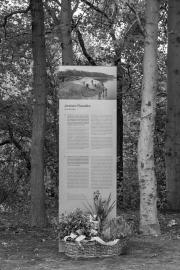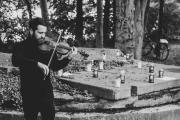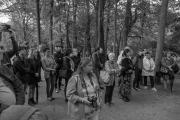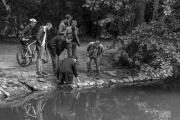The memory of water
Thanks to the determination of community organisers, a commemorative plaque was placed by Lake Rusałka's waters. It honours Jewish and Polish workers tasked with the construction of that artificial lake during World War II. The banks of the lake were lined with matzevot from the Jewish cemetery in Poznań.
The first forced labour camps for Jews were established in Poznań and Wielkopolska in the first half of 1941. They were called Zwangsarbeitslager (forced labour camp), Judenarbeitslager (Jewish labour camp), Judenlager (Jewish camp, Julag) and Arbeitslager für Juden (a camp for Jews). Prisoners were employed by the municipal authorities, the Reich Railway and the General Directorate for the Construction of Highways in the Reich. In May 1942, the Reich's plenipotentiary for labour (Fritz Sauckel) handed over the supervision of all camps to the German Labour Front. It conducted registration, collected reports and filled managerial positions. There were 29 camps in the city and on its outskirts. At least 11,000 men and women, including Jews from Germany, Austria and Luxembourg, were imprisoned there. The larger camps included: the one at the Municipal Stadium, in Fort Radziwiłł, at Bielniki Street, in Krzesiny and Krzyżowniki. Jews died there out of exhaustion from work, disease and hunger, but they also died in executions. The labour camps were liquidated by order of Heinrich Himmler on August 9, 1943. The longest operating camp at Gnieźnieńska Street was open up until October 1943[1].
Prisoners deported to labour camps were marked with numbers which they also kept when they were transferred to another camp. In Poznań, members of the Wach- und Schliessgesellschaft (Society for the Protection and Supervision of Property) supervised the prisoners. They wore uniforms and were recognisable by their caps with two crossed keys on the band. Sporadically Poles were also employed as guards. A commandant administered the camp, a representative of prisoners was known as the Elder of the Jews (Judenälteste), whose duties included keeping order. The camp staff also included warehouse workers and people preparing meals.
The occupation authorities wanted to change the image of Polish cities and give them a national-socialistic character. The development of Poznań was considered a priority. For this purpose, Albert Speer, general director of the expansion of Berlin, came to the city on November 15, 1939[2]. The new investments included the river engineering works on Warta and modernisation of the river port. It also entailed the construction of an airport, a central cemetery, the seat of the German Labour Front, and an opera house for 1,600 spectators. Modernisation of parks and gardens and further afforestation were also involved. When Joseph Göbels became acquainted with these plans, he wrote in his diary: "Tremendous scale, so the whole thing is acceptable. Greiser tries very hard."[3]
Most of the Jews taken to forced labour camps in Poznań came from the Łódź ghetto. The decision to deport them was made on May 2, 1941. Administration of the ghetto was pressing for sending to Poznań Jews from provincial ghettos and not the one in Łódź itself. However, it did not work, and the first group of men from Łódź ghetto was transported to the camp on the Municipal Stadium in May. Nearly free labour force pleased Poznań's administration so much that they asked ghetto management for more transports. Additional 600 people were brought before June 10, and next 500 before July 2. Initially, the Jews from Łódź ghetto were glad to leave for a labour camp expecting an improvement of their situation, so up to 60 people ready to leave showed up daily in the Labour Office. It changed later when information about inhumane conditions prevailing in labour camps reached the ghetto. Soon deportations from small ghettos in the Wartheland started. The first group came to Poznań from the ghetto in Ozorków, next one (on June 26, 1941) from Włocławek. A week later came groups from Zduńska Wola, Brześć Kujawski, Chodecz, Lubraniec, Kowal and Izbica Kujawska.
One of the reports prepared by the Labour Office in Poznań stipulates that in November 1942 5062 men and 634 women were placed in camps or "work posts". Among placements for work was Krzyżowniki, a village that during the war was known as Steineck, where the Jews evicted from ghettos in Zduńska Wola and Koło were placed. The average level of employment in Krzyżowniki was 520 people. Records show one escape: on May 26, 1942, Chaim Silber and Chaim Cala fleed the camp. They came to Poznań from Włocławek ghetto and were first brought to the camp Fort Radziwiłł. Gendarmerie grabbed them after a month.
It is known that as a result of the epidemic typhus, 98 prisoners died in Krzyżowniki, and their bodies were cremated. It was difficult for people weakened by hunger and exhausting work to overcome the disease. There is an account by Załman Kłodowski who recalled the situation in Krzyżowniki as follows. "After some time, Jews were no longer led to work because they all fell ill. Every day, the corpses were taken away by Jews who could move. There was no medicine, no food. There were many sick people in each classroom - the camp was established in the former school building. Dead bodies lied in two rows in the corridor."[4]
Let us list the names of several prisoners that lost their lives in Krzyżowniki (Posen-Steineck), both victims of the epidemic typhus and people hanged. The names were uncovered by Anna Ziółkowska who used books of the crematorium in the Institute of Anatomy in Poznań. They were, among others, Hersz Berkowicz, Azriel Borstein, Aron Corndorf (from Koło), Hersz Cynamon, Jakob Freimann, Wolf Freister, Aron Frenkel, Wigdor Gliksmann, Josef Goldmann, Szmul Grafsmann, Motek Graudens, Kalme Israelowicz (from Koło), Jehuda Izbicki, Chil Jakubowski, Szmul Kalmann (hanged), Jakob Kaufman, Fawisz Keiser (hanged), Rachmiel Klapiak (from Zelów), Jakob Koenigsberg, Icek Kowalski (from Koło), Josef Kowalski (from Kowal), Mojsze Aron Kuczyński, Grojnem Kuczyński (hanged), Bauch Kudlitz, Zalme Kwackowski, Lejb Kwaczkowski (from Aleksandrów), Chil Lichtenstein, Josef Liwszyc, Godel Moszkowicz, Abe Rosen, Mojsze Rosen, Idel Saks, Josef Schneider, Aron Szajewicz, Szlama Sztajer, Berek Teitelblatt, Wolf Treister, Naftali Watenberg, Machel Wolkowitz, Jakob Zyck (hanged), Chaim Żurawski.
According to plans, a 1110 ha green complex was to be created in Poznań. Jewish prisoners were employed in the construction and worked from the Sołacki Park to Lake Kierskie. Most of the prisoners working on-site came from the camps in Krzyżowniki, Strzeszyn and Golęcin. Jews from the Krzyżowniki camp work on the construction of the artificial Lake Rusałka as well as Lake Kierskie and Bogdanka brook. They used crushed stone and brick to build access and walking alleys, torn down buildings and worked on sewers. Jerzy Osięgowski wrote in 1996 in the Express Poznański about Lake Rusałka citing memories of Tadeusz Adamczak who witnessed those events[5]:
"Jews work at Rusałka. Before that, there were clay pits. They levelled the ground, dug the lake, reinforced banks with tablets brought there from Jewish cemeteries [...] some of them worked waist-deep in the water. Jews worked on alleys as well. They crushed brick from the torn down brickyard at Niestachowska Street, spread it on the lanes and rolled. Three or four of them dragged a roller. If someone was ill or weak, they shot them. All of the alleys by the lake were made by Jews. So much sweat and blood are there."
Jewish tombstones Adamczak mentions that were used to bolster banks of the Lake Rusałka (and probably its bottom as well) came from the cemetery at Głogowska Street, destroyed in 1940-1941 by the German invaders. The fact that the matzevot remained in the water after the end of the war was no secret in Poznań. When the water level was dropping, they were visible to everyone walking on the shores of the lake. However, it was only in the 1990s that the tone they were written about shifted away from the historical tidbit. In the pages of Gazeta Wyborcza, Głos Wielkopolski, Gazeta Poznańska and Express Poznański, people began to notice the ambiguity of such places – signs of suffering and extermination of Jewish prisoners of forced labour camps. Demands were made to remove the matzevot from the water. And to set up commemorative plaques informing of the work carried out in this place, including the victims who lost their lives in inhumane conditions during the construction of the Rusałka artificial reservoir. Readers called the newspaper editorial offices to talk about the tombstones used in the garden architecture or pavements and curbs in Poznań's Sołacz district. Stefan Konopiński recalled: "A dozen or so years ago, I saw a large tombstone with Jewish inscriptions in the stream flowing into Lake Strzeszyńskie. Now it's probably covered in silt."[6] During a walk by the Lake Strzeszyńskie, Joanna Członkowska noticed that the dams protecting the nearby meadow against flooding were made of Jewish tombstones. The journalist writing about this case quoted the words of Alicja Kobus who assured that the matzevot from Strzeszynek would be placed at the site of Akiva Eger's grave on Głogowska Street.[7]
Publications and appeals to the authorities did not get much traction. There was an embarrassing silence, especially after the first initiative of Jan Kowalski, a local activist. On July 26, 2011, Kwiatkowski sent a letter to the mayor of Poznań, Ryszard Grobelny, appealing for the placement of a tablet at Lake Rusałka informing about the Jewish victims ("a commemorative plaque with an appropriate inscription"). He attached three other position statements to his letter. The first one, signed by the chairman of the Council of the Institute of History of the Adam Mickiewicz University in Poznań, contains the resolution adopted by the Council on November 7, 2011 "supporting the idea of erecting a monument at Lake Rusałka commemorating Jewish prisoners of labour camps in Poznań used by the German invaders to excavate the lake". Kwiatkowski was also supported by the Jeden Świat Association and the Miasteczko Poznań Association. The latter asked in a letter to the Mayor of Poznań "to take the right steps", noting: "Your gesture would be part of cultivating the memory of the Holocaust which had its dramatic pages in Poznań as well".
Years later, Jan Kwiatkowski recalled that the idea of erecting the monument was also presented then to the Cultural Committee of the Poznań City Hall. However, they did not take up the subject either. Meanwhile, new articles appeared in the local press, and activists took up new initiatives. In 2015 (on May 8-10), an event called "Rusałka of Oblivion" was organised by the lake. The Familijny Poznań Foundation and Marcin Mikołajczak, the manager of the Rusałka Recreation Center, brought to attention the tragic history of this place. Mikołajczak made contact with the POLIN Museum of the History of Polish Jews which organised the so-called "Museum on Wheels". Thanks to his efforts, a museum container with a small exhibition appeared by the lake, workshops for children and the youth were organised. The accompanying exhibition of Maciej Krajewski's photographs ("Jewish Traces") aroused so much interest that it was extended until June 21. About 7,000 Poznań residents visited the "Museum on Wheels" over three days.
In the following year, students of the Construction and Woodwork School Complex in Poznań discovered the "secrets of Rusałka" by participating in an educational project as part of the nationwide competition of the Karta Center: "Nearby History – Undiscovered, Untold, Unheard". A work submitted for the competition, the film "The Lake of Blood", prepared by a group of students presented the history previously unknown to them of the construction of Lake Rusałka. It was highly rated – got second place in the competition.
The originators of the most recent initiative, aimed at marking the worksites of Jewish prisoners of forced labour camps on Lake Rusałka, were Maciej Krajewski (Łazęga Poznańska Association) and Aleksander Przybylski (journalist). Przybylski recalled: "In the fall of 2019, an interpellation concerning, among other things, Lake Rusałka and the extraction of matzevot were submitted by the city councillor Andrzej Rataj. Maciej Krajewski, a photographer and social activist, made a separate appeal to the mayor. Volunteers declared their assistance in the extraction and cleaning of tombstones, and mayor of Poznań asked Aquanet to specify the technical conditions for such an operation."
Ultimately, the originators themselves announced a successful crowdfunding event and on September 1, 2020, a column with information in Polish and English was erected at Lake Rusałka. A moving inauguration ceremony gathered a group of Poznań residents who care for the memory of Jewish victims.
[1] The information on labour camps presented in the article comes mainly from the fundamental book on this subject by Anna Ziółkowska Obozy pracy przymusowej dla Żydów w Wielkopolsce w latach okupacji hitlerowskiej (1941-1943), Wydawnictwo Poznańskie, Poznań 2005.
[2] Alber Speer joined the Nazi Party on March 1, 1931. In 1932, he took up the first design requests from the party; from 1934 he was Hitler's chief architect. In 1937, Speer was appointed the general construction inspector of the Reich capital (Generalbauinspektor für die Reichshauptstadt) and, at Hitler’s request , prepared plans to rebuild the city into the capital of the world (the so-called Germania).
[3] Arthur Greiser, born January 22, 1897 in Środa (Wielkopolska). On September 21, 1939, he took over the civilian leadership in Poznań, and in November 1939 he became the governor of the Wartheland. After the war, he was executed on July 21, 1946 by hanging in the presence of thousands of people gathered on the slope of the Poznań citadel.
[4] Op. cit. Anna Ziółkowska
[5] Op. cit. Anna Ziółkowska
[6] Mariola Dymarska, Macewy między jeziorami? [in:] „Gazeta Wielkopolska”, 20. 02. 1998
[7] Piotr Bojarski, To nie sensacja? Może szkoda [in:] „Gazeta Wielkopolska”, 24.10.2012. The one mentioned above is the reconstructed Jewish cemetery in the yard of one of the tenement houses at 26 Głogowska Street, unveiled on April 30, 2008.





